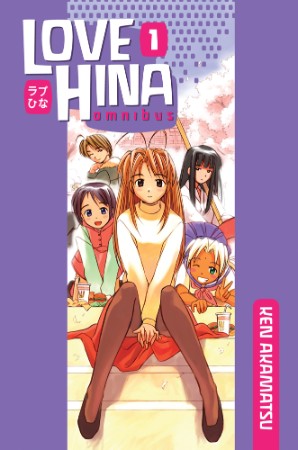By Ken Akamatsu. Released in Japan by Kodansha, serialized in the magazine Weekly Shonen Magazine. Released in North America by Kodansha Comics.
At the end of the last Love Hina omnibus, we left our hero and heroine having just failed their entrance exams. We open this second volume with Keitaro depressed. This is his third straight failure, and the pressure is on him to find something else to do with his life besides apply to Todai. What’s more, a dashing (if eccentric) young man has arrived in town. This is Seta, Naru’s crush, and Keitaro completely fails to measure up to him. Seta also brings along a young girl, Sarah, who like many bratty young girls in manga proceeds to abuse and belittle our hero at every turn. Is it any wonder Keitaro decides to give up?
I’ll be honest, I still find Keitaro a weakness in this series. Searching for a purpose in life is all very well and good, and god knows we’ve all done it. The trouble is that we haven’t all had six different women all find they have feelings for us. Keitaro is still mostly defined by his failures and his bad luck, and occasionally being polite. He needs to have a better goal than ‘get into university so I can meet my mysterious promised girl’. We actually do start to see the first hint of that here, but I only know this because I’ve read the series before. For a new reader who is unaware that Keitaro’s gluing pots together is foreshadowing, it’s just 3 more volumes of him accidentally walking in on women naked.
Speaking of the women, aside from Naru and Mutsumi, they’re once again given short shrift here. It amazes me that Negima has a cast of 31 main girls, as Akamatsu has enough trouble handling the 6 he has here. Shinobu, Motoko and Su continue to get a focus about every 15 chapters, and Kitsune gets even less than that. That said, Kitsune’s focus chapter was actually a high point of the volume, as we see her love of alcohol and mischief is tempered by a genuine desire to see Naru and Keitaro get over themselves. We also see that one should not try to play mind games with her unless one is prepared to face the consequences – she’s quite cunning. As for the others, Shinobu continues to worry about immaturity (and first kisses), and Motoko about being a samurai yet having romantic feelings. Su gets a brief chapter where we see what she might be like as an adult, but this doesn’t really change her personality noticeably.
The exception is Mutsumi, who gets her largest role here (she sadly appears less often as the series goes on, the curse of not actually living at the Inn). Mutsumi is a lot of fun, and the revelation that she’s actually quite intelligent and only failed one entrance exam as she forgot to put her name down is unsurprising. There are bigger revelations, however, as it becomes increasingly apparent to Naru that Mutsumi is the girl Keitaro made him promise to. This leads to a situation where Naru has to make a decision to give up on Keitaro in order to let him find his destiny. His destiny, of course, has spent the entire manga showing that she already knows that Keitaro and Naru are destined to be together. And once again true feelings end up getting buried (at least on Naru’s side – Mutsumi honestly seems OK with letting Keitaro go).
Love Hina continues to show the strengths that Akamatsu had at this time. Lots of physical comedy, lots of fanservice, and the ability to develop a cliched yet likeable romantic plot. It also shows off many of his weaknesses, which he would improve on with Negima. In the end, though, the big drawback is that I’m not a 22-year-old guy anymore, and Love Hina is a title that’s very rewarding for 22-year-old guys but very frustrating for ones who are older and more mature. For pure nostalgia reasons, this is worth a buy, however. And I seem to recall the next volume should be more interesting.



